
|
Brightened rapidly, and it reached to 5 mag in early June (June 5, Yoshimi Nagai). It will approach to the sun down to 0.4 A.U. in July, and it was expected to reach up to 2-3 mag. However, its brightening has stopped after that. It was 4.9 mag in late June (June 24, Carlos Labordena). It was faint as about 6 mag on July 2 (Todd Augustyniak). Now it is not observable. In the Southern Hemisphere, it will appear in the morning sky at 9 mag in late Augut. Then it keeps observable while fading rapidly. In the Northern Hemisphere, it is will never be observable again.
Date(TT) R.A. (2000) Decl. Delta r Elong. m1 Best Time(A, h)
July 31 8 58.07 -1 27.2 1.682 0.811 20 6.5 18:44 ( 85, -3)
Aug. 7 9 11.73 -8 3.3 1.766 0.944 24 7.4 18:48 ( 77, -3)
|

|
It passes the perihelion in August. But the condition of this apparition is bad. It is not observable in the Northern Hemisphere. In the Southern Hemisphere, it appears in the evening sky at 9 mag in late August, then it will keep observable while fading rapidly.
Date(TT) R.A. (2000) Decl. Delta r Elong. m1 Best Time(A, h)
July 31 8 33.89 20 37.4 1.390 0.379 2 8.1 5:28 (257,-18)
Aug. 7 9 35.21 13 49.0 1.316 0.336 7 7.6 18:48 ( 99,-10)
|

|
Brightened rapidly. Now it is so bright as 8.5 mag (July 18, Marco Goiato). It keeps observable bright as 9-10 mag for a long time until autumn. A thin straight dust trail is visible.
Date(TT) R.A. (2000) Decl. Delta r Elong. m1 Best Time(A, h)
July 31 1 0.65 -9 16.5 0.677 1.449 116 9.3 4:27 (180, 64)
Aug. 7 1 13.36 -10 24.3 0.665 1.465 119 9.3 4:12 (180, 65)
|
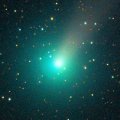
|
It brightened up to 7.9 mag in April and May (May 5, Juan Jose Gonzalez). Now it is fading. But it is still bright as 9.4 mag (July 18, Juan Jose Gonzalez). It keeps observable for a long time until when it fades out in the Northern Hemisphere. It will be visible visually until autumn.
Date(TT) R.A. (2000) Decl. Delta r Elong. m1 Best Time(A, h)
July 31 8 0.35 55 58.5 2.609 1.919 38 11.3 5:28 (219,-28)
Aug. 7 8 4.97 54 47.8 2.648 1.983 40 11.6 5:23 (220,-26)
|

|
It brightened up to 15.5 mag in January (Jan. 31, C. Rinner, F. Kugel). It is not observable now. The condition of this apparition is bad. It will reach up to 11-12 mag from spring to autumn, but it is not observable.
Date(TT) R.A. (2000) Decl. Delta r Elong. m1 Best Time(A, h)
July 31 7 36.95 16 15.0 2.352 1.398 15 11.8 5:28 (253, -4)
Aug. 7 7 59.41 14 30.0 2.362 1.418 16 11.9 5:23 (255, -3)
|

|
Brightening rapidly. Now it is 14.3 mag (Aug. 1, Toni Scarmato). A bit fainter than expected, but it should be visible visually around 13 mag. This apparition is best condition. It will approach to the earth down to 0.12 A.U. in October, and brighten up to 5 mag. It will be visible with naked eyes. In the Northern Hemisphere, it keeps observable all through this apparition until 2011 June when it fades down to 17 mag.
Date(TT) R.A. (2000) Decl. Delta r Elong. m1 Best Time(A, h)
July 31 22 27.28 23 19.8 0.715 1.577 130 12.9 1:54 (180, 32)
Aug. 7 22 31.76 26 15.2 0.634 1.516 132 12.3 1:31 (180, 29)
|

|
It reached up to 7.7 mag in last summer (Aug. 13, Chris Wyatt). It is fading now. It has already faded down to 11.9 mag (July 7, Marco Goiato). In the Southern Hemisphere, it keeps observable for a long time after this. In the Northern Hemisphere, it is only observable in the extremely low sky. It will be getting lower gradually, then it will never be observable again.
Date(TT) R.A. (2000) Decl. Delta r Elong. m1 Best Time(A, h)
July 31 17 56.80 -47 47.7 4.003 4.783 135 12.4 21:20 ( 0, 77)
Aug. 7 17 46.48 -47 53.6 4.131 4.829 128 12.5 20:43 ( 0, 77)
|
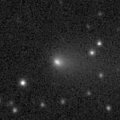
|
Now it is 11.5 mag (July 18, Juan Jose Gonzalez). It will keep 12-13 mag until autumn. But it locates somewhat low in the Northern Hemisphere.
Date(TT) R.A. (2000) Decl. Delta r Elong. m1 Best Time(A, h)
July 31 20 56.02 -32 27.6 1.613 2.609 165 12.8 0:24 (180, 87)
Aug. 7 20 50.49 -32 57.2 1.636 2.623 163 12.9 23:46 (180, 88)
|
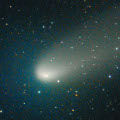
|
It reached up to 9.2 mag in March (Mar. 20, Marco Goiato). Now it is fading. It has already faded down to 12.6 mag (July 31, Marco Goiato). It keeps observable in a good condition for a long time. It keeps observable until autumn when it fades down to 16 mag.
Date(TT) R.A. (2000) Decl. Delta r Elong. m1 Best Time(A, h)
July 31 15 2.15 -13 32.2 1.772 2.181 99 13.7 18:44 (169, 68)
Aug. 7 15 11.89 -14 26.4 1.886 2.222 95 13.9 18:48 (154, 68)
|

|
Now it is unobservable. It will appear in the morning sky again in October.
Date(TT) R.A. (2000) Decl. Delta r Elong. m1 Best Time(A, h)
July 31 10 0.87 9 10.1 7.155 6.223 21 14.2 18:44 (103, 3)
Aug. 7 10 5.64 8 41.1 7.191 6.224 16 14.2 18:48 ( 99, -2)
|

|
Now it is 14.8 mag (July 16, Siding Spring Survey). It is expected to keep so bright as 6-8 mag for a long time from 2011 to 2012, and to be observable in good condition in the Northern Hemisphere. In 2010, it is observable in good condition in the Southern Hemisphere while brightening slowly. It locates low in the Northern Hemisphere, but it keeps observable until the end of 2010.
Date(TT) R.A. (2000) Decl. Delta r Elong. m1 Best Time(A, h)
July 31 23 41.49 -35 39.8 5.094 5.872 136 14.7 3:09 ( 0, 89)
Aug. 7 23 35.87 -36 14.6 4.982 5.812 141 14.6 2:36 ( 0, 89)
|
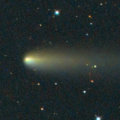
|
It brightened up to 9.5 mag in January (Jan. 13, Juan Jose Gonzalez). Now it is fading. But it is still bright as 14.1 mag (July 18, Hiroshi Abe). It will be also visible visually still now. It will be fainter than 18 mag at the end of 2010. In the Northern Hemisphere, it keeps observable for a long time, although it will be getting lower gradually.
Date(TT) R.A. (2000) Decl. Delta r Elong. m1 Best Time(A, h)
July 31 14 53.36 51 6.6 3.994 3.909 77 14.8 18:44 (176, 4)
Aug. 7 14 59.25 49 37.5 4.082 3.965 76 15.0 18:48 (172, 5)
|

|
Now it is 15.3 mag (July 18, Hiroshi Abe). It will be observable at 13-14 mag for a long time from 2011 to 2012. In 2010, it is observable at 15-16 mag in good condition from spring to autumn.
Date(TT) R.A. (2000) Decl. Delta r Elong. m1 Best Time(A, h)
July 31 21 15.14 0 49.8 5.948 6.904 158 15.2 0:43 (180, 54)
Aug. 7 21 8.69 0 24.3 5.895 6.872 163 15.1 0:09 (180, 55)
|

|
Now it is very bright as 14.2 mag (July 8, Toni Scarmato). Maybe it is 13 mag visually. It keeps observable at 14-15 mag for a long time in 2010.
Date(TT) R.A. (2000) Decl. Delta r Elong. m1 Best Time(A, h)
July 31 17 26.46 41 53.3 4.167 4.537 105 15.2 20:50 (180, 13)
Aug. 7 17 25.28 41 29.6 4.200 4.532 102 15.2 20:22 (180, 14)
|
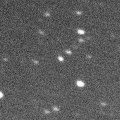
|
Now it is 15.0 mag (June 2, Hidetaka Sato). It keeps bright as 14-15 mag for a long time after this until 2013. It is observable in good condition in the Southern Hemisphere. However, it is not observable in the Northern Hemisphere.
Date(TT) R.A. (2000) Decl. Delta r Elong. m1 Best Time(A, h)
July 31 14 21.55 -47 38.2 6.363 6.624 100 15.2 18:44 ( 36, 73)
Aug. 7 14 20.88 -47 34.7 6.436 6.596 94 15.2 18:48 ( 46, 69)
|
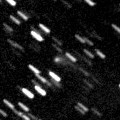
|
Now it is 16.5 mag (July 11, C. Rinner, F. Kugel). It keeps observable while fading gradually, and it will be fainter than 18 mag in November.
Date(TT) R.A. (2000) Decl. Delta r Elong. m1 Best Time(A, h)
July 31 5 10.97 57 19.1 2.821 2.381 54 16.4 5:28 (204,-11)
Aug. 7 5 32.67 58 54.5 2.818 2.428 57 16.5 5:23 (203,-12)
|
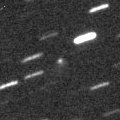
|
Now it is 16.7 mag (June 13, Hidetaka Sato). It will be observable at 17 mag in good condition in summer.
Date(TT) R.A. (2000) Decl. Delta r Elong. m1 Best Time(A, h)
July 31 19 48.02 -1 11.8 2.463 3.429 158 16.8 23:10 (180, 56)
Aug. 7 19 31.59 -0 33.1 2.513 3.439 151 16.9 22:27 (180, 55)
|

|
Not recovered in this return yet. It will be getting brighter and higher after this. It is expected to be observable at 15.5 mag in good condition from autumn to winter.
Date(TT) R.A. (2000) Decl. Delta r Elong. m1 Best Time(A, h)
July 31 4 33.60 10 58.3 2.517 2.189 59 17.2 5:28 (225, 32)
Aug. 7 4 46.55 11 55.5 2.441 2.177 63 17.1 5:23 (222, 32)
|
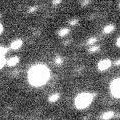
|
It was observed at 17 mag in summer and autumn in 2009. It will be observable again at 17 mag in good condition in summer and autumn also in 2010.
Date(TT) R.A. (2000) Decl. Delta r Elong. m1 Best Time(A, h)
July 31 2 49.82 22 4.5 2.506 2.552 80 17.1 5:28 (193, 32)
Aug. 7 2 57.87 22 28.3 2.436 2.569 85 17.1 5:23 (189, 32)
|
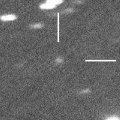
|
Now it is 17.4 mag (July 11, C. Rinner, F. Kugel). It keeps 17 mag for a long time from 2009 to 2012. It is observable in good condition in the Northern Hemisphere.
Date(TT) R.A. (2000) Decl. Delta r Elong. m1 Best Time(A, h)
July 31 2 29.09 21 12.2 8.248 8.237 85 17.2 5:28 (188, 33)
Aug. 7 2 27.26 21 16.9 8.113 8.227 92 17.2 5:23 (181, 34)
|

|
Now it is 17.4 mag (July 20, Yasukazu Ikari). It keeps observable at 17-18 mag for a long time until 2011 summer.
Date(TT) R.A. (2000) Decl. Delta r Elong. m1 Best Time(A, h)
July 31 19 9.63 12 50.9 3.266 4.110 141 17.3 22:32 (180, 42)
Aug. 7 18 57.03 12 56.6 3.298 4.093 136 17.3 21:52 (180, 42)
|
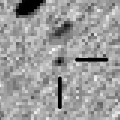
|
Now it is 19.3 mag (July 21, W. Hasubick). It will be observable at 17 mag in good condition from autum to winter. But actually, it is much fainter than expected.
Date(TT) R.A. (2000) Decl. Delta r Elong. m1 Best Time(A, h)
July 31 2 19.73 30 11.1 2.289 2.422 85 17.6 5:28 (184, 25)
Aug. 7 2 27.10 32 19.0 2.210 2.421 89 17.6 5:23 (181, 23)
|
|
![]()
 10P/Tempel 2
10P/Tempel 2 C/2009 K5 ( McNaught )
C/2009 K5 ( McNaught ) 43P/Wolf-Harrington
43P/Wolf-Harrington 103P/Hartley 2
103P/Hartley 2 C/2006 W3 ( Christensen )
C/2006 W3 ( Christensen ) 65P/Gunn
65P/Gunn 81P/Wild 2
81P/Wild 2 29P/Schwassmann-Wachmann 1
29P/Schwassmann-Wachmann 1 C/2009 P1 ( Garradd )
C/2009 P1 ( Garradd ) C/2007 Q3 ( Siding Spring )
C/2007 Q3 ( Siding Spring ) C/2006 S3 ( LONEOS )
C/2006 S3 ( LONEOS ) C/2008 FK75 ( Lemmon-Siding Spring )
C/2008 FK75 ( Lemmon-Siding Spring ) C/2009 F4 ( McNaught )
C/2009 F4 ( McNaught ) 126P/IRAS
126P/IRAS C/2010 J2 ( McNaught )
C/2010 J2 ( McNaught ) P/2002 X2 ( NEAT )
P/2002 X2 ( NEAT ) 219P/2009 H1 ( LINEAR )
219P/2009 H1 ( LINEAR ) C/2008 S3 ( Boattini )
C/2008 S3 ( Boattini ) C/2009 UG89 ( Lemmon )
C/2009 UG89 ( Lemmon ) 223P/2009 L18 ( Skiff )
223P/2009 L18 ( Skiff )![]()


















